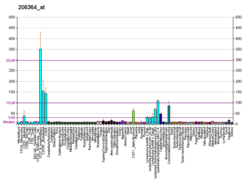KIF14
Kinesin-like protein KIF14 is a protein that in humans is encoded by the KIF14 gene.[5][6]
References
- GRCh38: Ensembl release 89: ENSG00000118193 - Ensembl, May 2017
- GRCm38: Ensembl release 89: ENSMUSG00000041498 - Ensembl, May 2017
- "Human PubMed Reference:". National Center for Biotechnology Information, U.S. National Library of Medicine.
- "Mouse PubMed Reference:". National Center for Biotechnology Information, U.S. National Library of Medicine.
- Nomura N, Nagase T, Miyajima N, Sazuka T, Tanaka A, Sato S, Seki N, Kawarabayasi Y, Ishikawa K, Tabata S (Dec 1995). "Prediction of the coding sequences of unidentified human genes. II. The coding sequences of 40 new genes (KIAA0041-KIAA0080) deduced by analysis of cDNA clones from human cell line KG-1". DNA Res. 1 (5): 223–9. doi:10.1093/dnares/1.5.223. PMID 7584044.
- "Entrez Gene: KIF14 kinesin family member 14".
Further reading
- Nakagawa T, Tanaka Y, Matsuoka E, et al. (1997). "Identification and classification of 16 new kinesin superfamily (KIF) proteins in mouse genome". Proc. Natl. Acad. Sci. U.S.A. 94 (18): 9654–9. doi:10.1073/pnas.94.18.9654. PMC 23244. PMID 9275178.
- Strausberg RL, Feingold EA, Grouse LH, et al. (2003). "Generation and initial analysis of more than 15,000 full-length human and mouse cDNA sequences". Proc. Natl. Acad. Sci. U.S.A. 99 (26): 16899–903. doi:10.1073/pnas.242603899. PMC 139241. PMID 12477932.
- Corson TW, Huang A, Tsao MS, Gallie BL (2005). "KIF14 is a candidate oncogene in the 1q minimal region of genomic gain in multiple cancers". Oncogene. 24 (30): 4741–53. doi:10.1038/sj.onc.1208641. PMID 15897902.
- Gruneberg U, Neef R, Li X, et al. (2006). "KIF14 and citron kinase act together to promote efficient cytokinesis". J. Cell Biol. 172 (3): 363–72. doi:10.1083/jcb.200511061. PMC 2063646. PMID 16431929.
- Corson TW, Gallie BL (2006). "KIF14 mRNA expression is a predictor of grade and outcome in breast cancer". Int. J. Cancer. 119 (5): 1088–94. doi:10.1002/ijc.21954. PMID 16570270.
- Carleton M, Mao M, Biery M, et al. (2006). "RNA interference-mediated silencing of mitotic kinesin KIF14 disrupts cell cycle progression and induces cytokinesis failure". Mol. Cell. Biol. 26 (10): 3853–63. doi:10.1128/MCB.26.10.3853-3863.2006. PMC 1488988. PMID 16648480.
- Olsen JV, Blagoev B, Gnad F, et al. (2006). "Global, in vivo, and site-specific phosphorylation dynamics in signaling networks". Cell. 127 (3): 635–48. doi:10.1016/j.cell.2006.09.026. PMID 17081983.
- Bowles E, Corson TW, Bayani J, et al. (2007). "Profiling genomic copy number changes in retinoblastoma beyond loss of RB1". Genes Chromosomes Cancer. 46 (2): 118–29. doi:10.1002/gcc.20383. PMID 17099872.
- Vasilescu J, Zweitzig DR, Denis NJ, et al. (2007). "The proteomic reactor facilitates the analysis of affinity-purified proteins by mass spectrometry: application for identifying ubiquitinated proteins in human cells". J. Proteome Res. 6 (1): 298–305. CiteSeerX 10.1.1.401.4220. doi:10.1021/pr060438j. PMID 17203973.
- Corson TW, Zhu CQ, Lau SK, et al. (2007). "KIF14 messenger RNA expression is independently prognostic for outcome in lung cancer". Clin. Cancer Res. 13 (11): 3229–34. doi:10.1158/1078-0432.CCR-07-0393. PMID 17545527.
- Madhavan J, Coral K, Mallikarjuna K, et al. (2007). "High expression of KIF14 in retinoblastoma: association with older age at diagnosis". Invest. Ophthalmol. Vis. Sci. 48 (11): 4901–6. doi:10.1167/iovs.07-0063. PMID 17962437.
This article is issued from Wikipedia. The text is licensed under Creative Commons - Attribution - Sharealike. Additional terms may apply for the media files.




